Movie Review – Dark Crystal, The
Okay, so we’ve already reviewed perennial favourite The Neverending Story here at the site, and we felt it was about damn time we turned our attention to the other of the Holy Family Puppet Films, those films that twinkle in our childhood and make us sigh with remembrance at being such innocents. Like The Neverending Story and Labyrinth, which used both humans and puppets (courtesy of Jim Henson and others), The Dark Crystal also uses puppets to tell its story. But unlike that great film, it uses them exclusively. Jim Hensons dark fable is both desperately melancholy, and brilliantly stylish, for those able to overcome the somewhat clunky direction.
– Summary –
Director : Jim Henson
Cast : Jim Henson, Kathryn Mullen, Frank Oz, David Goelz, Louise Gold, Brian Muehl, Mike Quinn, Tim Rose, Steve Whitmire.
Yyear of Release : 1982
Length : 90 Minutes
Synopsis: A young gelfling embarks on a quest to return a shard of a crystal to it’s rightful position, thereby bringing an ancient prophesy to fulfilment. The evil Skeksis seek to stop him, for if he succeeds, their reign of terror will be over.
Review : Dark and foreboding, almost a nightmarish tone of evil permeating every frame of this fantasy from Muppet creator Jim Henson, The Dark Crystal is a divisive and polarising cinematic effort. On a purely cinematic level, it’s an outstanding achievement in film, however, there will always be those who can’t get past its depressing nature, the dark, shadowy overtones that threaten to obliterate any emotion from the narrative.
******************
Okay, so we’ve already reviewed perennial favourite The Neverending Story here at the site, and we felt it was about damn time we turned our attention to the other of the Holy Family Puppet Films, those films that twinkle in our childhood and make us sigh with remembrance at being such innocents. Like The Neverending Story and Labyrinth, which used both humans and puppets (courtesy of Jim Henson and others), The Dark Crystal also uses puppets to tell its story. But unlike that great film, it uses them exclusively. Jim Hensons dark fable is both desperately melancholy, and brilliantly stylish, for those able to overcome the somewhat clunky direction.
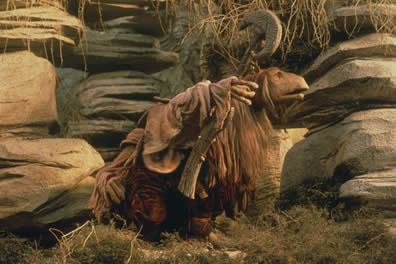
In the world of Thra, a young Gelfling named Jen believes that he is the last of his kind. He lives with his adoptive family of Mystics, giant hunchback creatures who dwell in a valley of peace and harmony. Thra is ruled by the evil Skesis, a race of giant vulture-like creatures who desire the annihilation of both the Mystics and the Gelflings. This is due to an ancient prophesy pertaining to the enormous Crystal in their castle: the Crystal is broken, and apparently the Skeksis fear the repair of it at the hands of a Gelfling, for it will bring their rule to an end.
It’s taken me a number of years to really appreciate The Dark Crystal. As a kid, I couldn’t handle the film’s nightmarish imagery and dark tone. The Skeksis scared the bejeebers out of me, and every time I saw Jen or Kira I had a bizarre feeling of attraction. Call me strange, but having a kind of empathy for two humanoid puppets wasn’t normal, and the result of this was that I resisted watching the film for a long time. I was an adult by the time I watched the film with unfiltered eyes, although Kira still gives me twinges in places she shouldn’t. Why am I admitting this? I don’t know. I guess as a point of catharsis, for this film is both a magical fantasy and a slow, dirge-like epic, I’m just trying to set the scene as to how I’m approaching it.
I dare say that when people first heard about The Dark Crystal, they might have thought Jim Henson had taken leave of his senses. After all, Henson had created the Muppets, and ever since lived in a world of primary colours, fun and joyous anarchy, with Kermit and Co creating havoc across the screen. A Muppet-less film, featuring all new characters, a generally dark and melancholy overtone, and no humans at all, might have seemed like a stretch. The characters he’d created for Labyrinth, for the various Muppet films, had all been fairly light hearted, lacking genuine evil and sense of dread. With The Dark Crystal, Henson was about to explore his darker side, and what a side it was. Filled with shadows and dread, Crystal took a standard fantasy quest flick and transformed it into an incredibly detailed, stylish (if misunderstood) instant classic, a film that today defies modern convention. Most audiences today would turn their noses up at such an unflattering film, a film seemingly more content to wallow in it’s sense of dread and kiddie-horror than anything approaching entertainment. Indeed, it’s hard to get past The Dark Crystals inherent cruelty, but if you try digging a little deeper, you’ll grow to appreciate just what a magnificent film achievement this is.
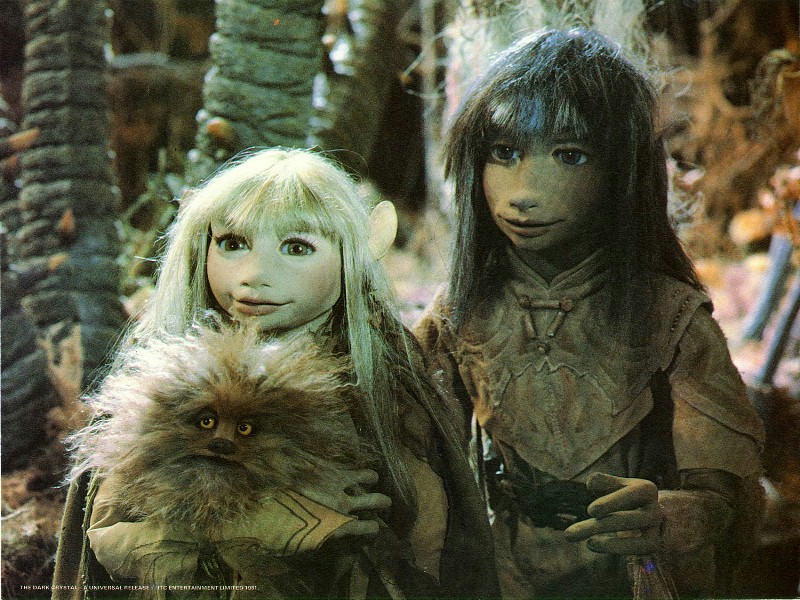
A quest film needs to have a number of things to succeed well: it needs epic scope, a grand wise old man, evil bad guys, a monumentally challenging motivation for the hero, and a hero who isn’t the strongest, wisest or most equipped to deal with the problems that will arise. A quest film is a metaphorical allegory for personal growth. Our hero, in this case Jen the gelfling, begins the film rather unabashedly un-heroic, and as far from the first pick of the littler to take on the challenge. Our wise old man in this instance is Jens Master, one of the Mystics, who dies at the very front of the movie after imparting some ancient wisdom and sets the quest up prior to leaving this earthly realm. And the evil villains are the Skeksis, skeletal rulers of the fantastic world of Thra. The quest, to return a shard of the Crystal to it’s original position within said crystal, reunifying the Skeksis and the Mystics into their original singular race (known as the urSkeks), is one of great danger and peril, a fact Jen realises only too well. Yet his wide-eyed innocence and small stature do not prevent him taking the challenge, and embarking on this great journey of self discovery. On a superficial level, Jen’s journey seems more like a simple walk through the woods to Grandma’s cottage, pursued all the while by the Big Bad Wolf, which is in this case the Skeksis, or rather, their various minions. Digging deeper, however, and the journey is as much an allegory for humanity as it is a simple fairy tale. The good and bad, personified to a simple, one-note caricature throughout the film (the Skeksis and the Mystics) are directly opposing forces, and while initially it’s felt by the audience that the Skeksis must be destroyed, Jim Henson wisely uses the fact they need to be incorporated into the Mystics in order to be complete to generate his most skillful story hook. I say wise because it’d be simple to have the Skeksis remain emotionally and characteristically devoid of saving, for al their hissing and posturing. But Henson makes us understand that, allegorically, humanity needs evil to exist to understand itself, and every person alive has booth good and evil inside them.
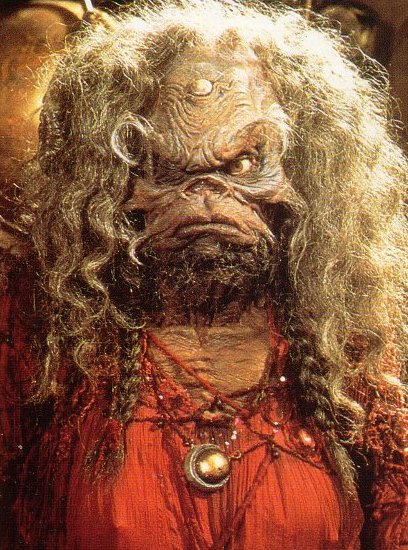
It’s a little “hippie” thinking, admittedly, but I think it works on a number of levels. Jen, representing the human Id, and Kira, representing all hot gelflings everywhere, seek to bring together two diametrically opposing forces, much the same way that humanity seeks to overcome its own failings. Henson uses magnum opus storytelling on a grand scale, to tell the most simple of human stories. Although, if you look at it, using puppets that in no way represent anything human (save for the gelflings) to get this point across can appear confusing. Still, the story itself is a lot deeper and more emotionally compelling than anything Henson had achieved before.
I think a lot of the problems people have with The Dark Crystal, aside from it’s dark themes, is the somewhat simplistic direction from Jim Henson himself. Flat camera angles, a lack of imagination to really utilise the grand set and production design, all leaves The Dark Crystal a plodding, slowly paced trial for the audience. Perhaps during the 80’s, when this film was produced, Henson was a revolutionary. But by today’s standards, he falls far from the mark in his ability to direct. Visionary, yes. Creative genius: sure thing. Adequate director of the medium of film? With The Dark Crystal, unfortunately not. perhaps a more accomplished director may have pulled The Dark Crystal from it’s limp pacing, a more energetic framing of scenes and dynamic use of the camera, lighting and editing would have worked wonders. The Dark Crystal seems at times to become bogged down with its own self-importance, almost bludgeoning the audience with its ideas instead of letting us figure it out for ourselves. Editor Ralph Kemplen, whose work on The African Queen, A Man For All Seasons, and The Day Of The Jackal was superb to say the least, here seems reluctant to give the film the pacing required for such a dark story. The films inherent limitations, given the puppet-themed nature of the production, perhaps gave him issues, or perhaps it was the guiding hand of Henson (and co-director Frank Oz) who “handled” the majority of this films editorial content. Whichever it may be, The Dark Crystal is an endurance test for modern audiences more accustomed to three second edits and YouTube brevity. For the more discerning viewer, I tend to think a conservative viewpoint is more appropriative of Henson’s original vision.
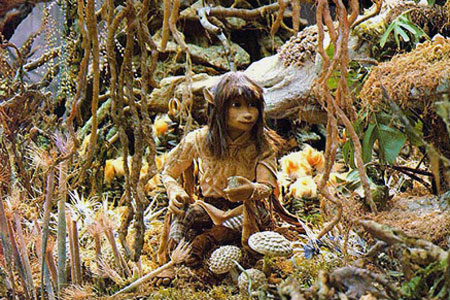
As with most stuff associated with Jim Henson, the puppeteering work is again fantastic. A fully realised world, filled with creatures beyond count of all shapes and unearthly sizes, is given complete authority on scree due to the diligence of Henson and his puppeteering crew. The Skeksis do appear a little clumsy sometimes, although this is mostly hidden by their astoundingly cool costume design. Overall, though, you cannot fault the performances of the puppets and the production design, which holds up under scrutiny today (excepting a few rather obvious matte shots throughout!). Elsewhere in the production, the set design and “locations” used throughout the film are utterly captivating in their complexity and inspiration. No doubt scrutinised every step of the way by Henson, The Dark Crystal‘s lavish production design cannot be called anything less than one of the most stylishly mounted films of the 80’s. With a much maligned (yet vastly underrated) score from the great Trevor Jones (who also scored Labyrinth, as well as The Last Of The Mohicans, Arachnophobia, GI Jane, Notting Hill and the recent remake of Around The World In 80 Days) accompanying the seething undertones of darkness, The Dark Crystal remains a visual treat for even the harshest of critics.
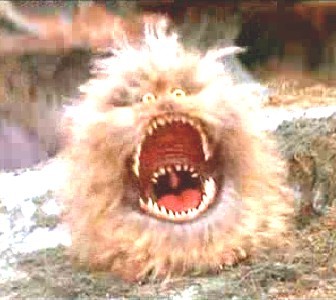
Retrospectively, there’s probably plenty of things about The Dark Crystal that Henson (prior to his untimely death) would have wanted to change had he lived to today’s modern age of computer technology. However, as a product of its time, The Dark Crystal remains one of the most polarising of all “puppet” films, sitting alongside Labyrinth for cult classic status. Whether or not you enjoy it will depend largely on your tolerance for a film so utterly un-Muppetty as you can get, and also whether or not you can see past the dark themes and slightly depressing nature of the storytelling to uncover what I believe to be one of cinemas most enduring love stories. The Dark Crystal remain essential cinematic viewing for lovers of the medium, however, your appreciation for it’s style may waver towards the negative.

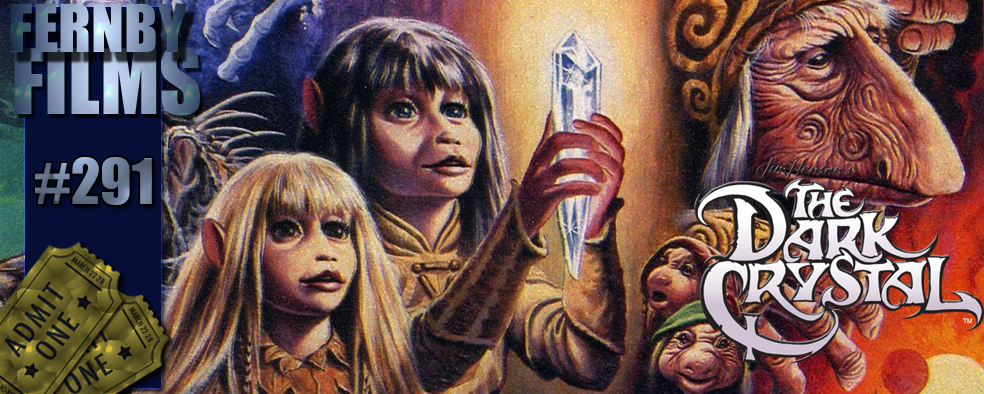






It was a great movie for kids only.